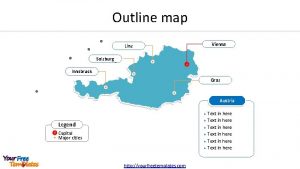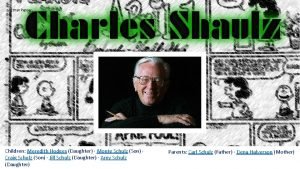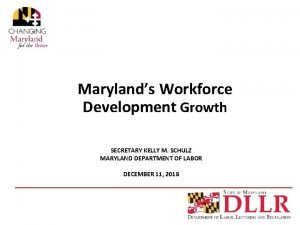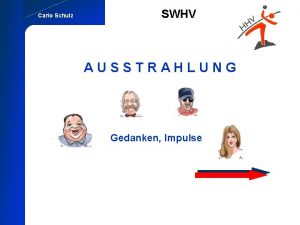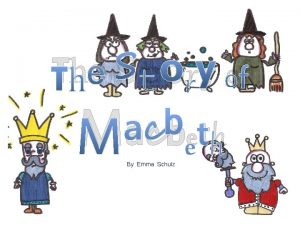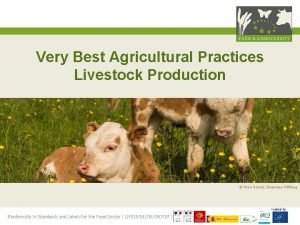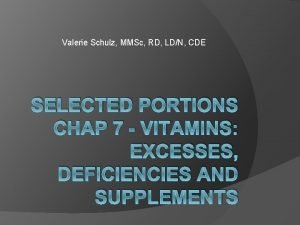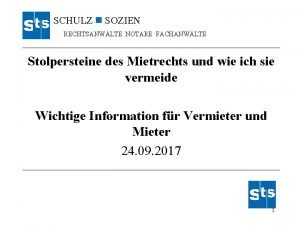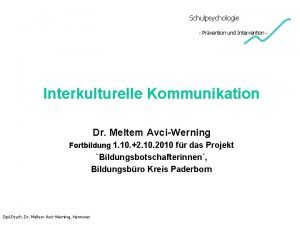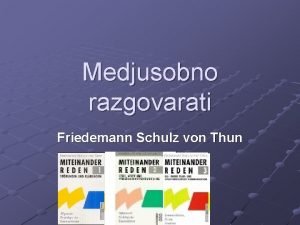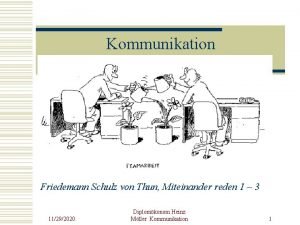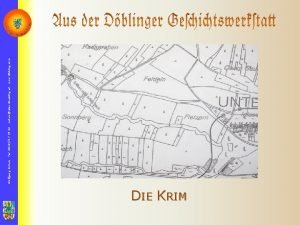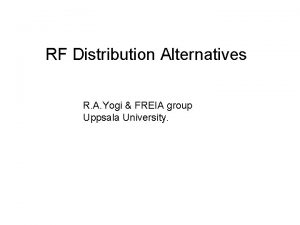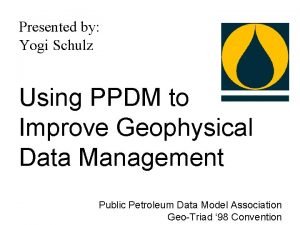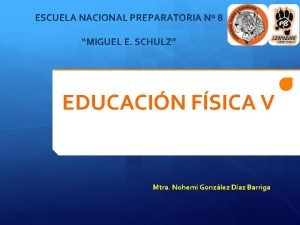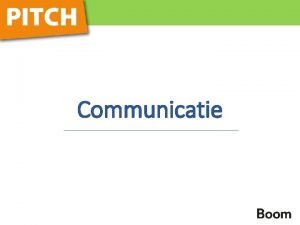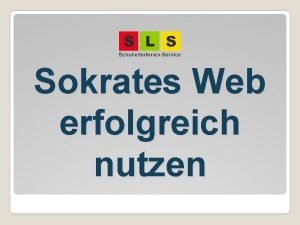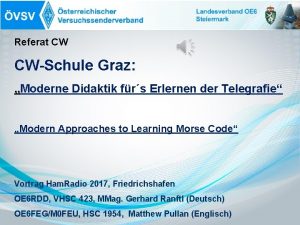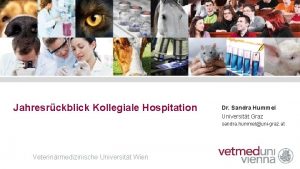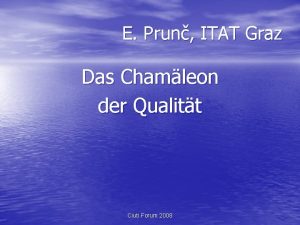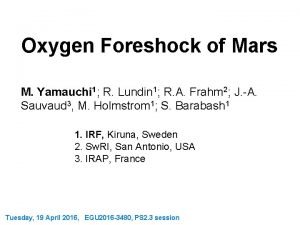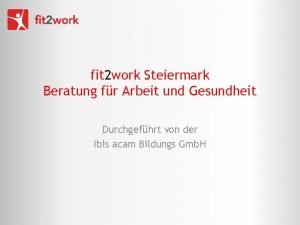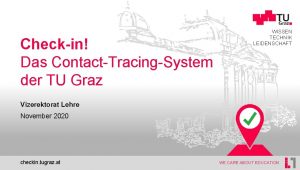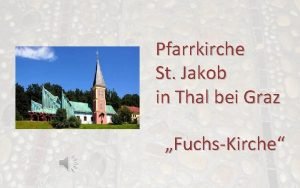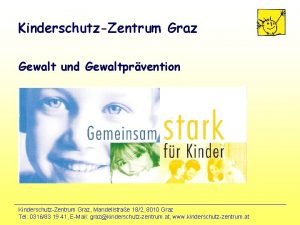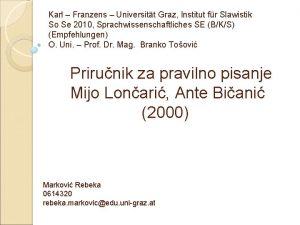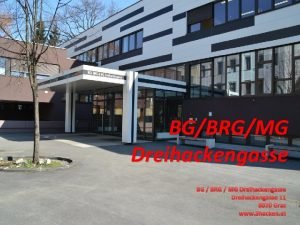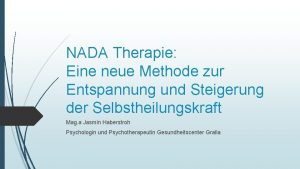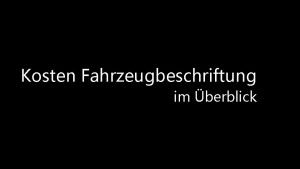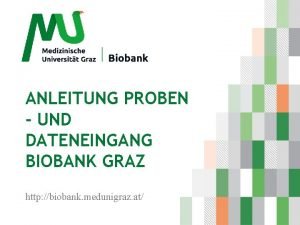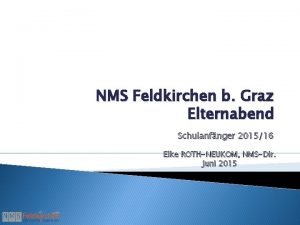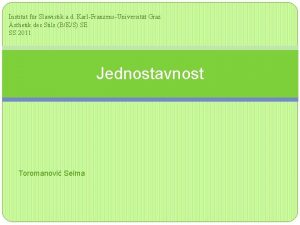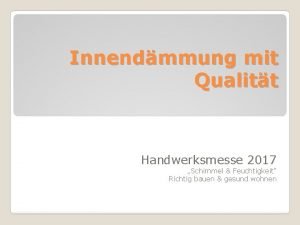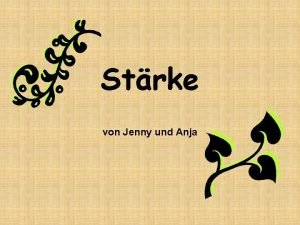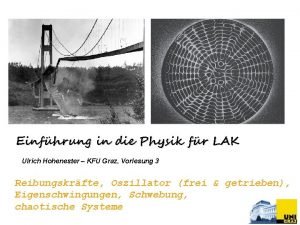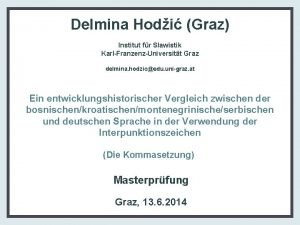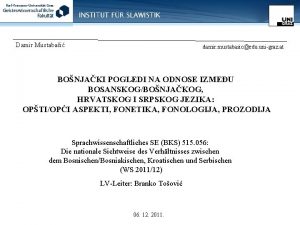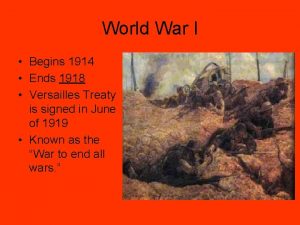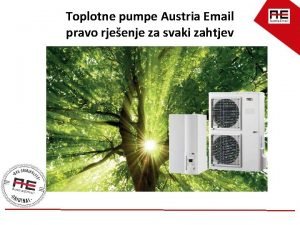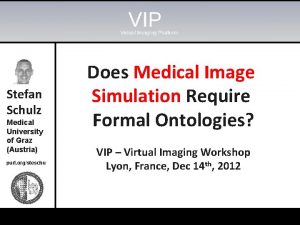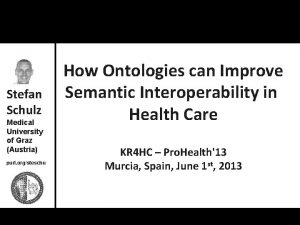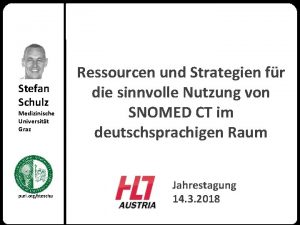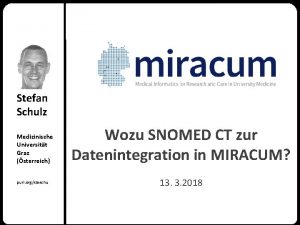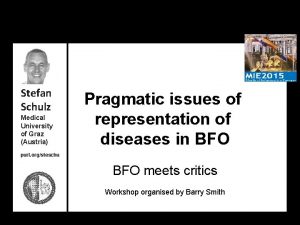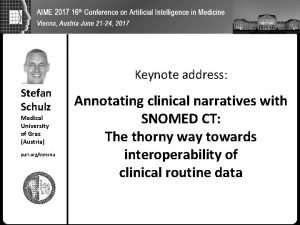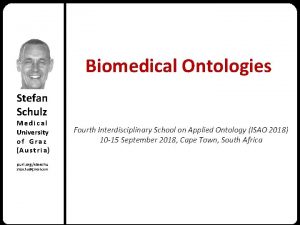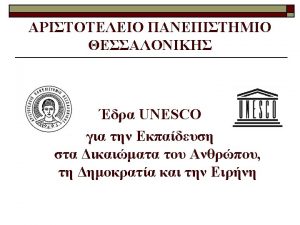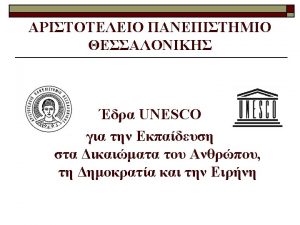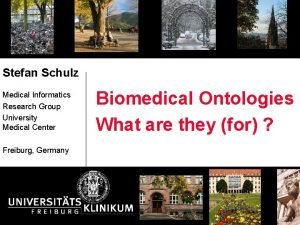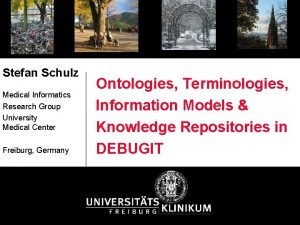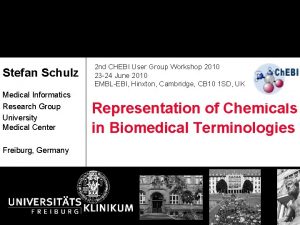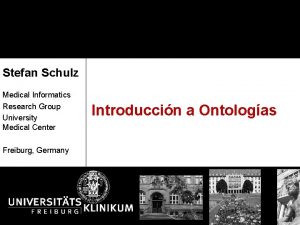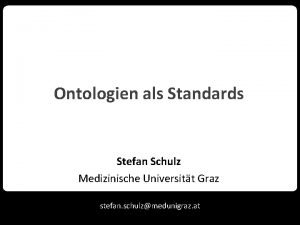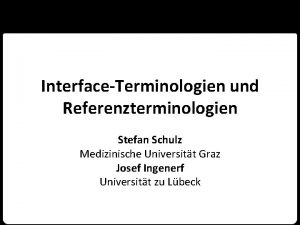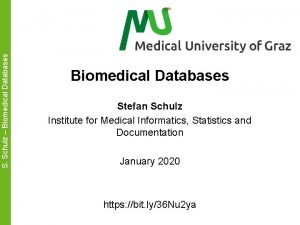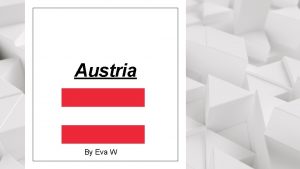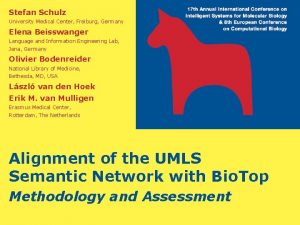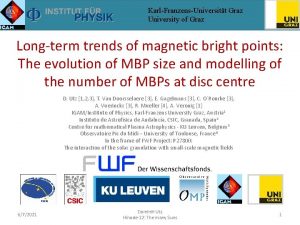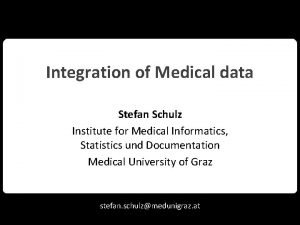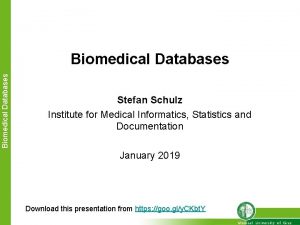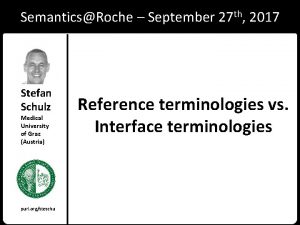Stefan Schulz Medical University of Graz Austria purl










![User Interface Terminology (e. g. Portuguese) [chemistry] [oncology] "Ca" "Cálcio" "Ca" "Câncer" "Carcinoma" Reference User Interface Terminology (e. g. Portuguese) [chemistry] [oncology] "Ca" "Cálcio" "Ca" "Câncer" "Carcinoma" Reference](https://slidetodoc.com/presentation_image_h2/b5df95f4119561d7d11ce00717eb7cc6/image-11.jpg)





![Results Concept coverage [95% CI] SNOMED CT Alternative Clinical model annotations . 79 [. Results Concept coverage [95% CI] SNOMED CT Alternative Clinical model annotations . 79 [.](https://slidetodoc.com/presentation_image_h2/b5df95f4119561d7d11ce00717eb7cc6/image-17.jpg)

























- Slides: 42

Stefan Schulz Medical University of Graz (Austria) purl. org/steschu Fifth Annual Workshop of the Clinical and Translational Science Ontology Group Amherst, NY, Sep 7 – 8, 2016 Keynote address: Coding clinical narratives: Causes and cures for inter-expert disagreements

Purpose of the talk § To report on empirical studies that scrutinized clinical terminologies / ontologies for EHR interoperability (in a European context) § To expose typical examples and analyze reasons for disagreement between manual annotations with SNOMED CT § To discuss how and whether ontology can support interoperability and mitigate the effects of intercoder disagreement § To defend empirical methods to guide terminology / ontology engineering

Benchmarking ontologies in action

Context of study: ASSESS-CT § European project on the fitness of purpose of SNOMED CT as a core reference terminology for the EU: www. assess-ct. eu § Feb 2015 – Jul 2016 § Scrutinising clinical, technical, financial, and organisational aspects of reference terminology introduction § Main recommendations: § "SNOMED CT is the best candidate for a core reference terminology for cross-border, national and regional e. Health deployments in Europe. " § Must be part of an ecosystem of semantic assets

Context of study: ASSESS-CT § European project on the fitness of purpose of SNOMED CT as a core reference terminology for the EU: www. assess-ct. eu § Feb 2015 – Jul 2016 § Scrutinising clinical, technical, financial, and organisational aspects of reference terminology introduction § Main recommendations: § "SNOMED CT is the best candidate for a core reference terminology for cross-border, national and regional e. Health deployments in Europe. " § Must be part of an ecosystem of semantic assets

Ecosystem of semantic assets Process Models Information Models Terminologies Guideline Models

Information Models Reference Terminologies …describe and standardize a neutral, language-independent sense • The meaning of domain terms • The properties of the objects that these terms denote • Representational units are commonly called “concepts” • RTs enhanced by formal descriptions = "Ontologies" Guideline Models

• • Information Models AT 3 AT 2 Core Reference Terminology • Systems of non-overlapping classes in single hierarchies, for data aggregation and ordering. aka classifications, e. g. the WHO classifications Typically used for health statistics and reimbursement AT 1 AT 4 Aggregation Terminologies (Classifications) Guideline Models

• • • Reference and aggregation terminologies represent / organize the domain They are not primarily representations of language They use human language labels as a means to univocally describe the entities they denote, independently of the language actually used in human communication AT Information Models • • AT 3 2 Core Reference Terminology • Systems of non-overlapping classes in single hierarchies, for data aggregation and ordering. aka classifications, e. g. the WHO classifications Typically used for health statistics and reimbursement AT 1 AT 4 Guideline Models

• • • Information Models Collections of terms used in written and oral communication within a group of users Terms often ambiguous. Entries in user interface terminologies to be further specified by language, dialect, time, sub(domain), user group. User Interface Terminology (language specific) Guideline Models
![User Interface Terminology e g Portuguese chemistry oncology Ca Cálcio Ca Câncer Carcinoma Reference User Interface Terminology (e. g. Portuguese) [chemistry] [oncology] "Ca" "Cálcio" "Ca" "Câncer" "Carcinoma" Reference](https://slidetodoc.com/presentation_image_h2/b5df95f4119561d7d11ce00717eb7cc6/image-11.jpg)
User Interface Terminology (e. g. Portuguese) [chemistry] [oncology] "Ca" "Cálcio" "Ca" "Câncer" "Carcinoma" Reference Terminology 5540006 | Calcium (substance) | 68453008 | Carcinoma (morphologic abnormality) |

User Interface Terminology AT 3 Information Models AT 2 RT 1 Process Models RT 4 Core Reference Terminology AT 1 RT 2 AT 4 RT 3 Guideline Models

ASSESS CT investigations § Performance of human experts for 1. Terminology binding to clinical models 2. Annotating of clinical narratives § Quality of annotation of clinical narratives using natural language processing § End points § Concept coverage, inter-annotator agreement (1. , 2. ) § Term coverage (2. )

ASSESS CT investigations § Performance of human experts for 1. Terminology binding to clinical models 2. Annotating of clinical narratives § Quality of annotation of clinical narratives using natural language processing § End points § Concept coverage, inter-annotator agreement (1. , 2. ) § Term coverage (2. )

Terminology binding to clinical models § Resources § § 12 information model extracts, 101 elements Full SNOMED CT vs. set of ICD-10, ATC, LOINC, and Me. SH 6 experts from 6 countries (5 EU + US) Method § § SNOMED CT vs. compilation of other international terminologies (English interface terminology) Complete annotation by by each expert

Annotation of clinical narratives § Resources § § § Parallel corpus: 60 clinical text samples from 6 languages, translated to all languages, representing clinical disciplines, document types and document sections For each language: 2 annotators * 40 samples 20 samples annotated twice Comparing § § SNOMED CT vs. UMLS - (SNOMED - Read – inactive sources -U. S. terminologies) + non. UMLS translations (artificial alternative core terminology as required by EU call)
![Results Concept coverage 95 CI SNOMED CT Alternative Clinical model annotations 79 Results Concept coverage [95% CI] SNOMED CT Alternative Clinical model annotations . 79 [.](https://slidetodoc.com/presentation_image_h2/b5df95f4119561d7d11ce00717eb7cc6/image-17.jpg)
Results Concept coverage [95% CI] SNOMED CT Alternative Clinical model annotations . 79 [. 76 -. 82] . 51 [. 57 -. 55] Text annotations . 86 [. 82 -. 88] . 88 [. 86 -. 91] Term coverage [95% CI] SNOMED CT. 68 [. 64; . 70]. 47 [. 44; . 52] Alternative. 73 [. 69; . 76]. 35 [. 32; . 40] Inter annotator agreement Krippendorff's Alpha [95% CI] SNOMED CT Alternative Clinical model annotations . 61 [. 55 -. 66] . 47 [. 41 -. 54] Text annotations . 37 [. 33 -. 41] . 36 [. 32 -. 40] Text annotations – English Text annotations – Swedish Krippendorff, Klaus (2013). Content analysis: An introduction to its methodology, 3 rd edition. Thousand Oaks, CA: Sage.

Agreement map: text annotations SNOMED CT UMLS SUBSET green: agreement – yellow: only coded by one coder – red: disagreement

Interoperability Scenario 1 Structured / Semi-structured Representation Coded / formal representation #1 Annotator achine) (human / m Annotator #2 (human / mach ine) Agreement/ Disagreement

Interoperability Scenario 2 Structured / Semi-structured Representation Language A Translation Language B Coded / formal representation Annotat or (human #1 / machin e) Agreement/ Disagreement ator #2 Annot / machine) n (huma

Further Analysis § Creation of gold standard § 20 text samples annotated twice 208 NPs § Analysis of English SNOMED CT annotations by two additional terminology experts § Consensus finding where disagreements, following pre-established annotation guidelines § Inspection and analysis of text annotation disagreements § Inspection and analysis of disagreements in the clinical model annotation example

Reasons for disagreement

Human issues (I) § Lack of domain knowledge / carelessness Tokens Annotator #1 IV 53240008 |Structure of abductor hallucis muscle (body structure) Annotator #2 80622005 |Abducens nerve structure (body structure) Gold standard 80622005 |Abducens nerve structure (body structure) § Disregard of annotation guideline Tokens No ptosis Annotator #1 2667000 |Absent (qualifier value) 11934000 |Ptosis of eyelid (disorder) Annotator #2 – 11934000 |Ptosis of eyelid (disorder) Gold standard – 11934000 |Ptosis of eyelid (disorder)

Human issues (II) § Retrieval error (no interface term found) Tokens Annotator #1 Glibenclamide 384978002 | Glyburide (substance) Annotator #2 – Gold standard 384978002 | Glyburide (substance) § Others: § Editing (mistyping) § Disregard of terminology specific constraints

Annotation guideline issues § Underspecification § e. g. put anatomy concept always in procedure or disorder context Tokens IV Annotator #1 Annotator #2 Gold standard 39322007 |Trochlear nerve structure 171674005 |Exploration of of trochlear nerve (IV) (procedure)| § more general: avoid isolated primitive concepts § Contradictions within annotation guidelines § absence of preference rules

Ontology issues (I) § Polysemy ("dot categories")* Tokens Annotator #1 Annotator #2 Gold standard Lymphoma 118600007 |Malignant lymphoma (disorder)| 115244002 |Malignant lymphoma - category (morphologic abnormality)| 118600007 |Malignant lymphoma (disorder)| § Incomplete definitions / pseudo-polysemy Tokens Annotator #1 Annotator #2 Gold standard Former 410513005|In the past (qualifier value) 8517006|Ex-smoker (finding) Smoker 77176002|Smoker (finding) 392521001 |History of (contextual qualifier) (qualifier value)| 8517006|Ex-smoker (finding) * A. Arapinis, L. Vieu: Complex categories in ontologies, FOIS 2014 Workshop on ontology and linguistics

Ontology issues (II) § Incomplete definitions Tokens Annotator #1 73211009 Diabetes |Diabetes mellitus (disorder)| 360152008 |Monitoring monitoring action (qualifier value)| Annotator #2 Gold standard 170742000 |Diabetic monitoring (regime/therapy)| § Navigational concepts (not for coding) Tokens Annotator #1 Annotator #2 palpebral fissure 301916005 |Finding 595000 |Structure of of measures of palpebral fissure (body structure)| (finding)| Gold standard 363934008 |Measure of palpebral fissure (observable entity)|

Ontological issues (III) § Normal findings, no full definitions Tokens Annotator #1 Annotator #2 Gold standard Motor: 127954009 |Skeletal muscle structure (body structure)| 106030000 |Muscle finding (finding)| 298300008 |Skeletal muscle normal (finding)| normal bulk and tone 17621005 |Normal (qualifier value)| 298300008 |Skeletal muscle normal (finding)| § Fuzziness of qualifiers Tokens Significant bleeding Annotator #1 Annotator #2 Gold standard 386134007 |Significant (qualifier value)| 131148009 |Bleeding (finding)| 24484000 |Severe (severity modifier) (qualifier value)| 131148009 |Bleeding (finding)| 6736007 |Moderate (severity modifier) (qualifier value)| 131148009 |Bleeding (finding)|

Interface term issues Tokens Annotator #1 Annotator #2 Gold standard Pain 406189006 |Pain observable (observable entity)| 22253000 |Pain (finding)| "pain observations" Tokens Annotator #1 87612001 |Blood (substance)| 76676007 extravasati |Extravasation on (morphologic abnormality)| Blood Annotator #2 Gold standard 50960005 |Hemorrhage (morphologic abnormality)| "extravasation of blood" Tokens Annotator #1 Annotator #2 Gold standard anxious 48694002 |Anxiety (finding)| 79015004 |Worried (finding)| 48694002 |Anxiety (finding)| "anxious cognitions"

Language issues § Ellipsis / anaphora § "Cold and wind are provoking factors as well. " (provoking factors for angina) § "These ailments have substantially increased since October 2013" (weakness) § Context § "No surface irregularities" (breast) § "Significant bleeding" (gastrointestinal bleeding) § "IV" (intravenous? Forth cerebral nerve? Type 4) § Co-ordination: § "normal factors 5, 9, 10, and 11 " § Negation § "no tremor, rigidity or bradykinesia"

Prevention of annotation disagreements

Prevention of annotation disagreements § Users (humans, text processing algorithms) § Training § Tooling § Guideline enforcement by appropriate tools § Post-co-ordination § Machine-processable annotation rules § Context awareness, scoping (e. g. looking back for anaphora resolution, identification of content of text passages) § Support by comprehensive, well-curated interface terminologies, tailored to the specific sublanguage to be analyzed

Preventive measures (SNOMED CT structure) § Fill gaps § equivalence axioms (reasoning) § Self-explaining labels (FSNs) § Scope notes where necessary (e. g. what means "entitic") § Remove unnecessary ambiguity § Flag concepts that should not be used (navigational concepts, anatomic "entire" concepts) § Strengthen ontological foundations § § Upper-level ontology alignment Formalize constraints (SNOMED CT concept model) Ontology / information model boundary Overhaul problematic subhierarchies, especially qualifiers

Preventive measures (SNOMED CT content maintenance) § Include large-scale analysis of real data in routine maintenance process § Harvest notorious disagreements between notorious text passages and value sets with concepts § Compare concept frequency across institutions and users to detect imbalances § Stimulate community processes for ontologyguided content evolution: § SNOMED CT ontological content § Interface terminologies for languages, specialties, users § Linking interface terminologies / value sets with SNOMED CT codes or expressions

Remediation of annotation disagreements

Remediation of annotation disagreements § Dependencies / Inferences Concept A Mast cell neoplasm (disorder) Isosorbide dinitrate (product)| Palpation (procedure)| Blood pressure taking (procedure) Increased size (finding) Finding of heart rate (finding)| Electrocardiogram finding (finding)| Concept B Mast cell neoplasm (morphologic abnormality) Isosorbide dinitrate (substance) Palpation - action (qualifier value) Blood pressure (observable entity) Increased (qualifier value) Heart rate (observable entity) Electrocardiographic procedure (procedure) Electrocardiogram finding (observable entity) Dependency A subclass. Of Associated. Morphology some B A subclass. Of Has. Active. Ingredient some B A subclass. Of Method some B No connection A subclass. Of Interprets some B No connection

Experiment § Gold standard expansion: § Step 1: include concepts linked by attributive relations: § A subclass. Of Rel some B § Step 2: include additional first-level taxonomic relations: § A subclass. Of B § Apply to results from English and Swedish annotator

Result Language of text sample English Swedish Gold standard expansion F measure no expansion 0. 28 expansion step 1 0. 28 expansion step 2 0. 29 no expansion 0. 14 expansion step 1 0. 15 expansion step 2 0. 15 § Minimal improvement § Side observation (English vs. Swedish): § Translation effects § Interface terminology effects

Work in progress (I) § Transformation of code groupings in plausible postcoordinated expressions: § Source group: - 24 Hour electrocardiogram (procedure) - Cardiac arrhythmia (disorder) § Pattern: Procedure (procedure) -> {Has focus (attribute)-[Clinical finding (finding)]} § Pattern frequency in SNOMED CT : 748 (frequent) § Suggested representation: 24 Hour electrocardiogram (procedure) -> {Has focus (attribute)-[Cardiac arrhythmia (disorder)]} § Limitations: ambiguities (e. g. substance - disorder)

Work in progress (II) § Enrichment of reference standard by maximally post-coordinated expressions Tokens wounds Gold standard codes 416462003 |Wound (disorder)| to the left eyelid 7771000|Left side 262749000|Open wound of eyelid; 313261004|Open wound of chin and chin 262749000|Open wound of eyelid; 313261004|Open wound of chin Gold standard post-coordinated expression "262749000 |Open wound of eyelid (disorder)|: { 116676008 |Associated morphology (attribute)| = 59091005 |Open wound (morphologic abnormality)|, 363698007 |Finding site (attribute)| = (51360009 |Skin structure of eyelid (body structure)|: 272741003 |Laterality (attribute)| = 7771000 |Left (qualifier value)|) } + 313261004 |Open wound of chin (disorder)|: { 116676008 |Associated morphology (attribute)| = 59091005 |Open wound (morphologic abnormality)|, 363698007 |Finding site (attribute)| = (30291003 |Chin structure (body structure)|: 272741003 |Laterality (attribute)| = 7771000 |Left (qualifier value)|) }"

Conclusion § Lack of inter-annotator agreement impairs successful use of clinical terminologies /ontologies § SNOMED CT slightly better than alternative scenario § Prevention: § Education, tooling, annotation / coding guidelines § Content quality improvement: labelling, scope notes, ontological clarity, full definitions, community processes, large-scale clinical data analysis § Importance of interface terminologies, dealing with ambiguity § Mitigation § Classical language understanding challenges § Resolution of agreement issues still speculative, e. g. machine-supported post-co-ordination § Research required

§ Acknowledgements: ASSESS CT team: Jose Antonio Miñarro-Giménez, Catalina Martínez-Costa, Daniel Karlsson, Kirstine Rosenbeck Gøeg, Kornél Markó, Benny Van Bruwaene, Ronald Cornet, Marie-Christine Jaulent, Päivi Hämäläinen, Heike Dewenter, Reza Fathollah Nejad, Sylvia Thun, Veli Stroetmann, Dipak Kalra § Contact: stefan. schulz@medunigraz. at
 Austria map outline
Austria map outline Monte schulz
Monte schulz Kelly m schulz
Kelly m schulz Una notte di giugno caddi pirandello
Una notte di giugno caddi pirandello Carlo schulz
Carlo schulz Emma schulz
Emma schulz Traueranzeige sven schulz greifswald
Traueranzeige sven schulz greifswald Valerie schulz
Valerie schulz Schulz sozien
Schulz sozien Schulz von thun
Schulz von thun Schulz von thun miteinander reden
Schulz von thun miteinander reden Selbstoffenbarungsohr
Selbstoffenbarungsohr Wolfgang schulz döbling
Wolfgang schulz döbling Bruno schulz art
Bruno schulz art Wr1150 circulators
Wr1150 circulators Yogi schulz
Yogi schulz Preparatoria numero 8
Preparatoria numero 8 Beïnvloedingstheorieën
Beïnvloedingstheorieën Websokrates bs tirol
Websokrates bs tirol Cw schule graz
Cw schule graz Sandra hummel uni graz
Sandra hummel uni graz Interkulturelle kommunikation graz
Interkulturelle kommunikation graz Yamauchi graz
Yamauchi graz Fit for work
Fit for work Checkin tu graz
Checkin tu graz Ernst fuchs kirche thal
Ernst fuchs kirche thal Kinderschutzzentrum graz
Kinderschutzzentrum graz Slawistik graz
Slawistik graz Arabisch lehrer steyr
Arabisch lehrer steyr Nada therapie graz
Nada therapie graz Kosten fahrzeugbeschriftung
Kosten fahrzeugbeschriftung Biobank graz
Biobank graz Nms feldkirchen klassen
Nms feldkirchen klassen Slawistik graz
Slawistik graz Sz bauwerksabdichtung graz
Sz bauwerksabdichtung graz Berblick
Berblick Efkon graz
Efkon graz Newtonsche bewegungsgleichung
Newtonsche bewegungsgleichung Slawistik graz
Slawistik graz Hodza u graz muhamed
Hodza u graz muhamed Was austria hungary a country
Was austria hungary a country Mozart was born
Mozart was born Austria email lwpk 8 eco
Austria email lwpk 8 eco
